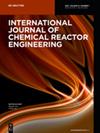Green hydrogen production in Uruguay: a techno-economic approach
IF 1.2
4区 工程技术
Q4 ENGINEERING, CHEMICAL
International Journal of Chemical Reactor Engineering
Pub Date : 2024-07-09
DOI:10.1515/ijcre-2024-0066
引用次数: 0
Abstract
In 2015, the participants of the Paris Agreement collectively acknowledged the urgent need for immediate actions to decarbonize their national economies, with the aim of mitigating the adverse impacts of climate change. There is a call for policymakers to step up efforts to significantly reduce greenhouse gas (GHG) emissions in all economic sectors, with a focus on prioritizing options that can deliver substantial emission cuts. Some industry and transport subsectors present significant challenges in terms of technical and economic feasibility. Viable solutions for these sectors, known as “hard-to-abate” sectors, are limited. Green hydrogen has emerged as a promising alternative that is gaining increasing attention. It is poised to play a crucial role in transitioning towards a more sustainable future. There is a growing interest in green hydrogen among researchers, institutions, and nations, all committed to advancing its development, improving efficiency, and reducing costs. This paper explores the concept of green hydrogen, particularly its production processes that rely on renewable energy sources in Uruguay. It demonstrates the significant potential for green hydrogen production, facilitating the transition from fossil fuels to clean energy and promoting environmental sustainability through the widely accepted electrolysis process. Uruguay currently boasts a high percentage of renewable electricity generation (reaching 97 % in 2020). To support this further, there is a need to increase renewable energy capacity, which would impact the energy prices. The cost of energy accounts for more than 40 % of the levelized cost of hydrogen (LCOH) in all studied scenarios. Additionally, optimizing the costs associated with electrolysers, which can exceed 30 % of the LCOH in polymer electrolyte membrane (PEM) electrolysis, is crucial. This optimization is essential for positioning the country as a net exporter of green hydrogen. The range of LCOH values calculated in the different scenarios is between 2.11 USD/kg H2 and 4.12 USD/kg H2. According to updated specialized literature, achieving LCOH values under USD 1.4/kg H2 is essential for this goal.乌拉圭的绿色氢气生产:技术经济方法
2015 年,《巴黎协定》的参与者集体承认,迫切需要立即采取行动,使本国经济去碳化,以减轻气候变化的不利影响。呼吁政策制定者加大努力,大幅减少所有经济部门的温室气体排放,重点是优先考虑可实现大幅减排的方案。一些工业和运输分部门在技术和经济可行性方面面临重大挑战。这些被称为 "难减排 "部门的可行解决方案十分有限。绿色氢气已成为一种有前途的替代能源,受到越来越多的关注。它将在向更可持续的未来过渡方面发挥至关重要的作用。研究人员、机构和国家对绿色氢能的兴趣与日俱增,他们都致力于推动绿色氢能的发展、提高效率和降低成本。本文探讨了绿色氢气的概念,特别是乌拉圭依靠可再生能源的生产工艺。它展示了绿色制氢的巨大潜力,促进了从化石燃料向清洁能源的过渡,并通过广为接受的电解工艺促进了环境的可持续发展。乌拉圭目前的可再生能源发电比例很高(2020 年将达到 97%)。为了进一步支持这一目标,有必要提高可再生能源发电能力,这将对能源价格产生影响。在所有研究方案中,能源成本占氢气平准化成本 (LCOH) 的 40% 以上。此外,优化与电解槽相关的成本也至关重要,在聚合物电解质膜 (PEM) 电解过程中,电解槽成本可能超过平准化氢气成本的 30%。这种优化对于将我国定位为绿色氢气净出口国至关重要。不同方案计算出的 LCOH 值范围介于 2.11 美元/千克 H2 和 4.12 美元/千克 H2 之间。根据最新的专业文献,实现低于 1.4 美元/千克 H2 的 LCOH 值对实现这一目标至关重要。
本文章由计算机程序翻译,如有差异,请以英文原文为准。
求助全文
约1分钟内获得全文
求助全文
来源期刊

International Journal of Chemical Reactor Engineering
ENGINEERING, CHEMICAL-
CiteScore
2.70
自引率
12.50%
发文量
107
审稿时长
6-12 weeks
期刊介绍:
The International Journal of Chemical Reactor Engineering covers the broad fields of theoretical and applied reactor engineering. The IJCRE covers topics drawn from the substantial areas of overlap between catalysis, reaction and reactor engineering. The journal is presently edited by Hugo de Lasa and Charles Xu, counting with an impressive list of Editorial Board leading specialists in chemical reactor engineering. Authors include notable international professors and R&D industry leaders.
 求助内容:
求助内容: 应助结果提醒方式:
应助结果提醒方式:


